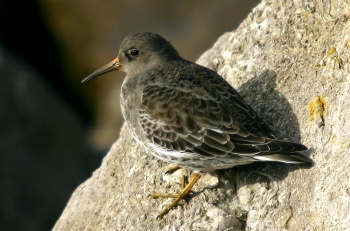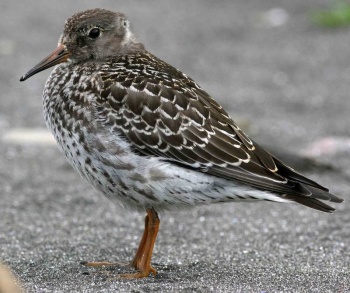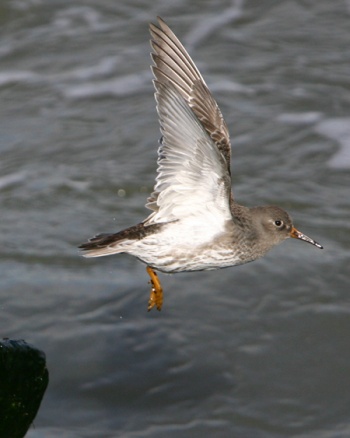- Calidris maritima
Identification
Length: 20–22 cm, wingspan 40–44 cm, weight 55–105 g
The bill is thin and dark with a yellow base, and the legs are short and greenish-yellow in summer, yellow in winter.
Summer: Dark grey-brown above and on breast, with brown fringes to scapular and mantle feathers
Winter: Ddark blackish-grey with a purple sheen on top, and white underneath. Lacks mantle scalloping and breast spotting. The breast is grey and the rump is black.
Juvenile: Similar to adult summer. White scalloping to mantle feathering.
Similar species
Apart from Rock Sandpiper, the only small dark wader with yellow legs likely to be seen on a rocky shore. In winter Rock Sandpiper best distinguished by distribution (Pacific coasts, versus Atlantic for Purple), but in breeding plumage Rock Sandpiper has bold dark belly patch. Mantle feather patterning differs subtly in Summer.
Distribution
Breeds on the arctic and arctic-alpine tundra of northern Europe (Iceland, Scandinavia), extreme northwestern Asia (east to Severnaya Zemlya), Greenland, and northeastern Canada. Winters on the Atlantic coasts of Europe and the USA, occasionally straying as far south as northern Spain and the Gulf Coast. Vagrant to California.
Taxonomy
Very closely related to Rock Sandpiper; in the past sometimes considered conspecific with it. Monotypic[1]. Purple Sandpiper is variable in size and bill length and four subspecies have been proposed in the past[2], C. m. maritima (Scandinavia, Russia, arctic Canada), C. m. groenlandica (Greenland), C. m. littoralis (Iceland), and C. m. belcheri (Hudson Bay, Canada), but genetic analysis showed they have minimal differentiation and intergrade extensively[3].
Habitat
Tundra and rocky coastal areas.
Behaviour
They form small flocks on rocky shores in winter, often with Ruddy Turnstones.
Breeding
The male makes several scrapes in the ground and the female chooses one, and lays 3-4 eggs. The male incubates and cares for the chicks.
Diet
The diet includes insects and molluscs, also some plant material.
Vocalisation
A low "weet-wit".
Purple Sandpiper voice clip
References
- Clements, J. F., T. S. Schulenberg, M. J. Iliff, D. Roberson, T. A. Fredericks, B. L. Sullivan, and C. L. Wood. 2018. The eBird/Clements checklist of birds of the world: v2018. Downloaded from http://www.birds.cornell.edu/clementschecklist/download/
- Engelmoer, M., & Roselaar, C. S. (1998). Geographical variation in waders. Dordrecht: Kluwer Academic Publishers.
- Barisas, D. A. G., et al. (2015). A review of the subspecies status of the Icelandic Purple Sandpiper Calidris maritima littoralis. Zoological Journal of the Linnean Society 175: 211–221.
- Hallgrimsson, G. T., Summers, R. W., Etheridge, B., & Swann, R. L. (2012). The winter range of Nearctic Purple Sandpipers Calidris maritima on the East Atlantic flyway. Ardea 100: 13–18.
- Leblanc, N., Stewart, D., Pálsson, S., Elderkin, M. F., Mittelhauser, G., Mockford, S., Paquet, J., Robertson, G., Summers, W. R., Tudor, L. & Mallory, M. (2017). Population structure of Purple Sandpipers (Calidris maritima) as revealed by mitochondrial DNA and microsatellites. Ecology and Evolution. 2017:1–18.
- Payne, L. X. and E. P. Pierce (2002). Purple Sandpiper (Calidris maritima), version 2.0. In The Birds of North America (A. F. Poole and F. B. Gill, Editors). Cornell Lab of Ornithology, Ithaca, NY, USA. https://doi.org/10.2173/bna.706
- Summers, R.W., Corse, C. J., Nicoll, M., Smith R. & Whitfield D. P. (1988) The biometrics and wintering area of Icelandic Purple Sandpipers, Ringing & Migration, 9:3, 133-138, DOI: 10.1080/03078698.1988.9673936
- Summers,R.W., Boland, H., Colhoun, K., Elkins N., Etheridge B., Foster S., Fox J. W., Mackie K., Quinn L.R. & Swann R.L. 2014. Contrasting trans-Atlantic migratory routes of Nearctic Purple Sandpipers Calidris maritima associated with low pressure systems in spring and winter. Ardea 102: 139–152. doi:10.5253/arde.v102i2.a4
- Van Gils, J., Wiersma, P. & Kirwan, G.M. (2018). Purple Sandpiper (Calidris maritima). In: del Hoyo, J., Elliott, A., Sargatal, J., Christie, D.A. & de Juana, E. (eds.). Handbook of the Birds of the World Alive. Lynx Edicions, Barcelona. (retrieved from https://www.hbw.com/node/53936 on 17 September 2018).
- Wikipedia contributors. (2018, September 4). Purple sandpiper. In Wikipedia, The Free Encyclopedia. Retrieved 07:56, September 17, 2018, from https://en.wikipedia.org/w/index.php?title=Purple_sandpiper&oldid=858086236
- Collins Pocket Guide to British Birds 1966
Recommended Citation
- BirdForum Opus contributors. (2024) Purple Sandpiper. In: BirdForum, the forum for wild birds and birding. Retrieved 25 April 2024 from https://www.birdforum.net/opus/Purple_Sandpiper
External Links
GSearch checked for 2020 platform.1







